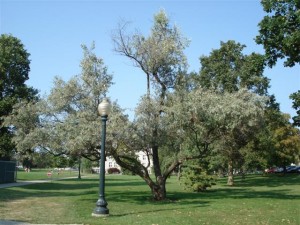I’m happy to say that Middlebury didn’t suffer much for tree damage from the storm I wrote about last week. Peak wind gust was only 34 MPH, but power was still out on campus for the better part of the morning. From what I understand a tree fell on a line near a substation. I’ll bet it was nice to have a half of a snow day-bet you thought you out-grew those once you graduated high school. It was nice to see the students making a productive use of their time. And yes, the guys in our landscape department feel bad when we have to plow some of them over. Like real estate, people, it’s all about location, location, location. Think before you sculpt, please.
We lost some branches here and there, notably in some White Pines near Hadley House and Perkins. Some large dead wood also fell out of Sugar Maples near Warner and Starr. Our vigorous pruning of trees on campus prevented a lot more damage, though, as most wood that falls out of trees is dead wood, and we remove much of that before it falls. Two trees did break some live wood, and I feel badly for them.
One is a rare (for this zone) Lacebark Elm in the front quad. You can see the broken tree as you drive south on Route 30.
This is a special little tree, and fortunately the break, while large, probably won’t permanently disfigure the tree. The damage was primarily one large scaffold branch breaking away from the main trunk, and was not surprising. This union between branch and trunk was a weak one, characterized by included bark growing between the two. As the bark on both stem and trunk expand through the years, it pushes against each other, causing the separation to widen. As you can see in the trunk close-up, the dark colored wood was always exposed to outside air-it is the light colored wood that was the sole attachment, and that is where it broke.
Proper pruning when this tree was young would have prevented this from occurring. Unions like this are easy to spot, and when removed young cause no permanent damage to the tree.
The other significant damage that occurred was more surprising, and also more sad. The wonderful Russian Olive tree just north of the new McCullough plaza lost a couple large branches on the right side, and will be much more noticeable when removed, disfiguring an admittedly funny tree-possibly the state’s largest.

This small tree is more often a large shrub-making this specimen quite old. The damage on the left side was from excessive end weight. As the snow collected on the tips of the branches the main stem could no longer hold it, and it broke. The species is not known for very strong wood; being a shrub at heart that is not very surprising.
We’ll prune away the damaged branches as best we can, and attempt some pruning on the other side to balance the rest of the tree out. I’ve been asked about replanting more of this species, but the plant is considered an invasive species, and is currently on the watch list by the Vermont Invasive Exotic Plant Committee. It’s wonderfully fragrant creamy yellow blossoms in June and July are followed by fruit widely spread by birds, replacing native plants. While birds do love this plant, better bird species richness is found in native plant stands. There are plenty of other fragrant trees and shrubs to pick from in June and July, but I do like the silvery leaves of this one.

I’m sorry to see the olive damaged — I love its silvery-gray leaves and old, gnarled trunk.